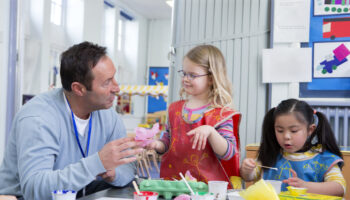By Aimee Currier
Are you looking for something different to do with the children in your care? Maybe you need a new way to reinforce or teach math concepts, language arts or nature/science. You might be hoping to find a fun way to get children involved in creating art. Believe it or not, a walk outside can help you to accomplish all these things.
When I was an Early Childhood teacher, taking walks with the children in my class was one of my favorite things to do, and it was a hit with the children as well. It was nice to be able to get out and see something different every now and then. It was a great opportunity to engage the children in some rich conversations while learning some concepts along the way.
Here are some ideas to get you thinking about how you might use this activity with the children:
Before you go:
- Talk about what season it is. What might you expect to see on your walk? Write their ideas on chart paper.
- Discuss expectations and how to stay safe.
- Read a story about taking a walk. Some suggestions can be found at the end of this article.
During your walk:
- Look for connections to math, science/nature and art.
- Math connections: Look for shapes. Count things you see, such as flowers, trees, street signs, cracks in the sidewalk… the possibilities are endless. Look for numbers on signs along the way.
- Nature/science: Stop at a tree and talk about the bark or the big roots. Compare different flowers/plants you see along the way. Gather up some acorns, leaves, pinecones, etc. These can be used for math and art connections as well (like asking “Who can identify the longest pinecone?”). Look for animals and have conversations about what they are doing.
- Art: Challenge the children to find the colors of the rainbow. Discuss different shades of the same color. Stop walking and look up at the sky. Ask if anyone sees an image in one of the clouds.
After your walk:
- Wash hands!
- Revisit the language chart you created earlier. Did the children see things they expected to see? What was different or unexpected?
- Recall what happened in the story from earlier. What was similar to the children’s real-life experience?
- Use the materials collected to engage in math activities. Count the acorns. Compare the sizes of leaves, etc.
- Allow the children to create using the materials. One fun idea is to “marble paint” using an acorn instead of a marble.
Although the primary focus up until now has been on how you can use a walk to enrich the activities in the classroom, I would be remiss if I didn’t mention the biggest benefit of taking a walk: exercise and fresh air! Enjoy!
Click http://www.walkarlington.com/the-next-step-to-get-kids-walking-reading/ for suggestions to connect reading to walking.




